Archive for the ‘Norway’ Category
52 Ancestors in 52 Weeks #26—Martha Hansdatter (1841-1900)
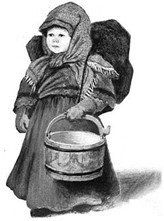 Martha Karoline Dorthea Hansdatter was born on 20 March 1841 on the Dungan farm in Øksnes, a municipality on the large island of Langøya in the county of Nordland, Norway. She was baptized in the Øksnes church in 1841 and confirmed there in 1858.
Martha Karoline Dorthea Hansdatter was born on 20 March 1841 on the Dungan farm in Øksnes, a municipality on the large island of Langøya in the county of Nordland, Norway. She was baptized in the Øksnes church in 1841 and confirmed there in 1858.
Her family included her father, the husmænd Hans Enok/Enoch Pedersen (1813-1898) and her mother, Maren Anna Serina Andersdatter (ca. 1812-1886). Martha had at least one sibling, her brother, Enok Andreas K. Hansen, born about 1850.
In 1861, twenty-year-old Martha gave birth to her first son, Johan Andreas Martinsen, son of Martin Grunbek Kaspersen. No record of a marriage to Martin has been found, but the baby’s patronymic Martinsen tells us that the father must have acknowledged the child.
Martha married Sivert Knudsen several years later on 11 September 1865 in Øksnes parish. The couple and young Johan settled on the Roten farm in Øksnes for a few years before moving on to nearby Valfjord. Only three of the eight children born over the next twelve years survived to adulthood:
- Kaspera Helmine Siversdatter (1866-?)
- Hans Edvard Sivertsen (1870-?)
- Sofie Marie Sivertsdatter (1878-1966)—my great-grandmother.
We know very little about Martha’s life outside of her role as a wife and mother. In 1885 she served as godparent for her granddaughter (Johan’s daughter) Olina Johansen.
Martha passed away on 21 October 1900 at the age of fifty-nine. She barely outlived her father Hans Pedersen who had died a couple of years before. Martha died from a lung problem, perhaps asthma or tuberculosis. Because the ground had already frozen at the time of her death, she was not buried until the next spring on 20 May 1901.
We cannot visit her grave today. In Norway, burial sites are rented for just 20 or 30 years. The rental contract can be renewed up to three times if the community has no immediate need for the grave. Once the family stops paying the rent or the contract expires, the headstone is removed, and the gravesite is reused. Today, we know Martha only through the Øksnes parish records. Her American grandchildren, all born after her death, knew next to nothing about her.
52 Ancestors in 52 Weeks #25—Sivert Knudsen (1843-1907)
 In Norway’s Nordland County, on the Vesterålen archipelago, the Øksnes municipality covers part of the large island of Langøya as well as many smaller islands north of there. Bø and Sortland municipalities share Langøya with Øksnes.
In Norway’s Nordland County, on the Vesterålen archipelago, the Øksnes municipality covers part of the large island of Langøya as well as many smaller islands north of there. Bø and Sortland municipalities share Langøya with Øksnes.
The Øksnes Church, built in 1703, stands on one of the small islands, Skogsøya. The actual parish grounds have been maintained since the 1400’s, and parts of the present church building date to the 1600’s.
Sivert Knudsen was born in this parish at Roten farm, probably on 23 July 1843, to Knud Sjursen and Brita Kristoffersdatter. The date is questionable because his baptism record does not provide a birth date, and subsequent records give conflicting information. Sivert’s confirmation record, arguably the most reliable record, (because the information likely would have been provided by his parents) gives the 23 July 1843 date. Sivert’s youngest daughter Sofie’s baptism registration offers an earlier birth year of 1842. His death record gives a third birth date of 3 June 1843. The July date is probably correct given that he was then baptized a month later on 27 August of that year. Norwegian babies were usually baptized shortly after birth.
When Sivert was a small boy, his family moved on to Hadsel parish. Sivert was confirmed there at age 17 on 9 June 1861. Of course, like most Norwegians, he had already received his smallpox vaccination several years earlier in 1856.
Until 1865, Sivert worked to help his father who was a tenant on the Bjørndal farm in Hadsel. That autumn on 11 September he returned to Øksnes and married 24-year-old Martha Karoline Dorthea Hansdatter. They wed in the same Øksnes church where his parents had been married. When Sivert married Martha, he acquired a step-son, Johan.
After Sivert and Martha married, they and her son settled on the Roten farm in Øksnes where Sivert had been born. Sivert made a living as a farmer and fisherman.
The couple lived at Øksnes for three years and began adding to their family. According to family records, they had twelve children in all, including:
- Johan Martinsen (Martha’s son and Sivert’s stepson, 1861- ca. 1889) eventually became a fisherman and married Jakobina Bergite Antonsdatter in 1884. His stepfather Sivert served as his best man. Johan and Jakobina had a daughter, Olina, and two sons, Helmer and Johan. The boys emigrated to America and married sisters, Alfreda and Marie Susag, in North Dakota. Helmer remained in that state where he farmed and raised a large family. Young Johan, who became known as Johnnie Johnsen, moved on to Bremerton, Washington. He, too, had a large family. Tragically, he died in 1947 while fishing in the Gulf of Alaska when he was washed overboard during a storm.
- Kaspera Helmine Sivertsdatter (1866- ), born at Øksnes. She was known as “Mina” by the family, and she married Petter Jentoft Nilsen, a shoemaker, in 1885 at Eidsfjord. They had 8 children and never left Norway.
- Anna Marie Birgitte Sivertsdatter (1868-1869) born at Øksnes, buried at Hadsel.
- Hans Edvard Sivertsen (1870-?), born at Valfjord. He was a fisherman and married Ingeborg Karoline Reinholdtsen in 1894. They had one son, Sydolf Sigvard Hansen in 1894. Hans and Ingeborg never left Norway.
- Karl Nordal Sivertsen (16-25 July 1872) born at Valfjord.
- Unnamed Sivertsdatter, stillborn 11 May 1874.
- Unnamed Sivertsen, stillborn 27 April 1876.
- Sofie Marie Sivertsdatter (1878-1966) born at Valfjord. Sofie married Ole Jørgen Bentsen in 1904 and emigrated to America the next year.
- Unnamed Sivertsdatter, stillborn 21 September 1882.
No record of the remaining reported children has been found.

Valfjord Wildflowers
Eventually the family left Øksnes and relocated to the settlement at Valfjord. By 1900, Sivert was a leaseholder in a fishing operation there. Over the years, he served as a baptism sponsor for several of the grandchildren:
- Johan’s daughter Olina Andrea Johansen baptized at home on Oshaug on 21 June 1885,
- Mina’s daughter Karoline Berntine Pettersdatter baptized 15 July 1888 at Eidsfjord parish, and
- Hans’ son Sydolf Sigvard Hansen baptized at home on 25 November 1894.
Martha passed away in 1900 leaving Sivert a widower. He died at Øksnes a few years later on 10 Dec 1907 at age 64. The ground was frozen so he was buried the next spring on 2 May 1908 at Eidsfjord i Hadsel parish, where his wife had been buried. No cause of death was recorded in the parish records.
52 Ancestors in 52 Weeks #24—Karen Marie Johansdatter (1851-1916)
Karen Marie Johansdatter, daughter of Johan Larsen (1824-1876) and Sara Andrine Möllersdatter (1814-1880) was born on 7 April 1851 at Titternes farm in the Næsna municipality of the Helgeland traditional region of Nordland, Norway. This farm lies on beautiful Dønna island in the part of Nordland county south of the Arctic Circle. There she was baptized at home on 15 June 1851. The Dønna i Næsna parish recorded this event.
She was confirmed at age 16 in the same parish on 23 June 1867. As was the case for most other Norwegians of the time, her confirmation record indicated that she had received the prerequisite smallpox vaccination.
I visited her birthplace on Dønna in 2013:
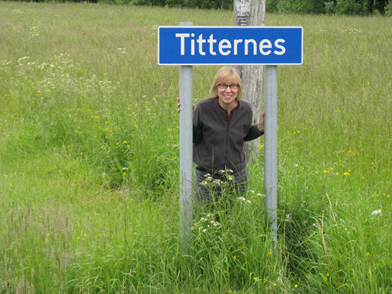
Karen’s family lived on several Dønna farms, ultimately residing on the Skeidsøen farm. They probably lived in modest wooden houses with a grass roofs.
Karen was a middle child in the family. Her siblings included:
- Johana Maria, born 25 September 1845;
- Bergitte Susanna, born 8 September 1848;
- Ludvig Edvard, born 17 May 1855;
- Anne Margrete Kristine, born 12 March 1859; and
- Mortine Lovise, born 19 June 1863.
On 11 August 1873, in Nordland’s Bø parish far away from her home on Dønna, Karen married Lorents Nikolai Möller Bentsen. He was 19 and Karen was twenty-two. How had she ended up in a place that even today is a day’s drive from where she grew up?
Assuming that couples usually married in the wife’s parish, we can surmise that Karen had relocated north to Bø at some point. A couple of explanations come to mind. Perhaps they met when he visited her island on one of his fishing expeditions and she then followed him back to Bø. Or maybe she traveled initially to the Bø area to join relatives or to work and became acquainted with him there. However it happened, the couple settled in Bø after their marriage.
The young bride often saw her family. Her sister Anne’s children, Fresenius and Helga, lived with Nick and Karen in 1900. So did her sister Johana’s granddaughter, Riborg. Perhaps she also met with her father a time or two when he visited the northern area to fish.
Nick and Karen raised their family of two daughters and a son in Bø. Once the children had grown, the two surviving children (Lena and Ole) both decided to emigrate to America, so Nick and Karen followed them in 1905.
They found work in Minnesota to save money for a homestead, and then they moved on to Montana where land was available. They settled in a Norwegian community near Medicine Lake in northeastern Montana.
There they farmed and raised sheep as everyone in Norway had done. In the spring they put their sheep on an island in Medicine Lake so they did not need herding. Karen had brought from Norway her spinning wheel, which would have been a valuable item. She could spin the wool and weave it into cloth to make clothing.
Nick became a naturalized citizen on 10 November 1913 at Plentywood, Sheridan County, Montana. At that time, women could not hold citizenship in their own right. They became citizens of their husband’s country. Karen, then, became a U.S. citizen, too, by virtue of Nick’s citizenship.
After seven years of homesteading, Karen died on 14 November 1916 at age 65. Although the State of Montana had kept death records since 1907, compliance was spotty in the early years, and they do not have a death record for her.
Nick finally acquired title to his own land the spring after Karen died. He received the patent for his homestead from the U. S. government on 25 June 1917. It must have been a bittersweet day without Karen.
With his wife no longer at his side, Nick took steps to sell out. He sold the land and auctioned off their belongings. What became of Karen’s spinning wheel? The family eventually lost track of it, and her granddaughter Signe Bentsen Fleming speculated that it was sold in the auction sale.
When Nick died two and a half years later, he was buried beside Karen at Big Lake [Homestead] Cemetery, not too far from where they homesteaded.
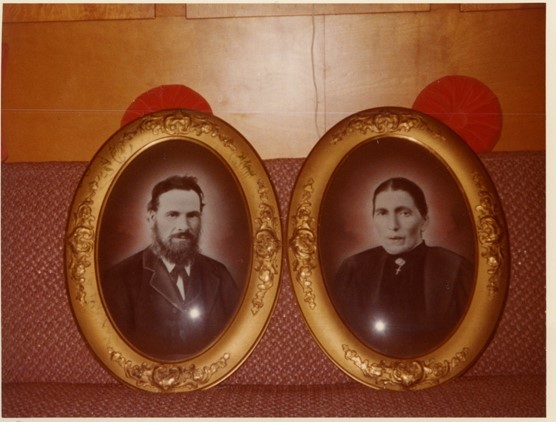
52 Ancestors in 52 Weeks, no. 23—Lorenz Nikolai Bentsen, 1854 – 1919
In the late nineteenth century, the Bentsen clan lived in Bø Municipality on the southern coast of the Vesterålen District of Nordland, Norway. There, on the Fjaervold farm on the island of Langøya, Lorenz Nikolai Möller Andersen was born on 5 July 1854 to Anders Bentsen and Anne Larsdatter. To shorten up this long name, he usually went by “Nick”.
When he was three months old, Nick was baptized into the Lutheran Church of Norway at the Bø parish church built in 1824. The pastor baptized several babies that day, the 16th Sunday after Trinity.
Bø kirke

Nick’s legal name has created some confusion. Our American family records do not match the official Norwegian records recording his name. Nick’s descendants remembered him as “Nikolai Lorenz” rather than “Lorenz Nikolai Möller”. Perhaps they assumed his first name was Nikolai because he went by the nickname “Nick”. They may never have known he had a second middle name because he seems to have dropped it after he came to America.
The descendants also knew him by the “Bentsen” surname he adopted when he immigrated to the United States. In Norway he had used the patronymic name, “Andersen”, derived from his father’s first name, rather than a surname. Norway did not require surnames until the 1920’s, long after Nick had left.
When Nick was born, his family consisted of his parents and an older sister, Kristine Andrea Andersdatter, born in 1851. An unnamed younger brother was stillborn in February 1857.
According to the Norwegian records, Nick’s father was Anders Bentsen (1823-1857). This lineage differs from what Nick’s granddaughter, Signe Bentsen Fleming, has reported in her book Bentsen-Sivertsen History 1800-1988. She states that Nick’s father was a man named Peter Kolbentsen.
Which is correct? Every Norwegian record lists Nick’s patronymic name as “Andersen”, not “Petersen”, indicating that his father’s name was in fact Anders, not Peter. Nick’s baptism, confirmation, and marriage records all report his father’s name as Anders Bentsen. Furthermore, both Nick and his son Ole took the surname Bentsen, not Kolbentsen, when they immigrated to the United States. Indeed, Ole and his sisters had used the Bentsen surname name occasionally even in Norway. It seems likely that Nick’s father was in fact Anders Bentsen. More research remains to be done on the identity of Peter Kolbentsen and his relationship to the family.
Nick’s father passed away in 1857 when the boy was just three years old. By 1865 Nick and his sister Kristine were living on different farms as foster children. “Necolai Andersen”, age 12, lived that year on the Svinøen farm owned by Nils Holgersen. Nick was listed in the household of Anders Grægusen (who had been one of his baptism sponsors) and his wife Andrea Krane.
A couple of years later on 30 May 1869 Nick was confirmed in the same Bø parish where he had been baptized. He was 14 years old. The record indicates he had received his smallpox vaccination four years earlier, in 1861.
On 11 August 1873, again in Bø parish, Nick married Karen Marie Johansdatter, daughter of Johan Larsen (1824-1876) and Sara Andrine Möllersdatter (1814-1880). Nick was 19 and Karen was twenty-two.
The couple lived on the remote island fishing village of Skjæringstad in Vesterålen, Nordland. Over the next several years they moved around to Svinøya and ultimately to Hadsel. Nick engaged in the treacherous fishing industry in addition to his farming work
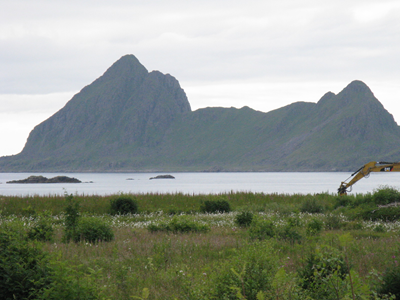
Skæringstad
During this time, they had at least four children:
- Peter Andreas Norum Lorentzen, born 13 September 1874 at Barstrand Farm. He was baptized 11 October 1874 but does not appear on the 1875 census, so he probably died in infancy.
- Lina Andrea Bentsen, born 29 January 1876 at Skæringstad. Lina worked as a seamstress until she was 28, and then she married Johan Jorgen Kristian Johansen in Hadsel in 1904. They moved on to Troms and had one daughter named Betty Karoline on 23 October that year. Nick and Karen both served as baptism sponsors for Betty. Lina’s family emigrated to the United States in 1909 and settled in Seattle. Johan disappears from the record after that, and Lina then married Emil Torbergsen in 1915. She died in Seattle at the age of 55 in 1932. Her daughter Betty married twice, first to James E. Harrigan about 1925 and then to Howard Cummings in 1949. Betty and Howard lived on Langley Island near Seattle, and there she came to a terrible end in 1954. While driving home from work one day, Howard heard on the radio that his 49-year-old wife had been found brutally murdered in the woods behind their home. A teenaged boy was tried for the crime but was acquitted. Later, a local handyman confessed to the murder.
- Riborg Oline Bentsen, born 18 April 1878 at Skæringstad. Riborg died in Hadsel parish on 13 July 1894 at the age of sixteen. The parish record does not give a cause of death.
- Ole Jörgen Bentsen, born 6 September 1880 at Svinøya. In 1904 Ole married Sofie Marie Sivertsdatter at Hadsel. Nick served as a baptism sponsor for their first child, Riborg Marie Hansene, on 23 October 1904 in the same parish. Interestingly, Riborg was baptized the same day her cousin Betty was born. Riborg’s baptism record gives her father’s residence as “Amerika”. By then, Ole had already emigrated to make a new home for his family. Sofie and the infant Riborg joined him the following spring.
By 1905, then, what was left in Norway for Nick and Karen? They were 51 and 54 years old, no longer young, living the hard, hard life of most Norwegians. They had buried two children in Bø. Their daughter had moved to Troms and perhaps already was making the plans for her eventual emigration in 1909. Their only surviving son and their nephew Fresenius had already gone to America.
In addition to these local concerns, big changes were in the wind in Norway that year. After nearly a century of Swedish rule, Norway achieved its independence that May. Uncertainty lay ahead. With no close familial ties in Bø, and facing life under a new and untested monarch, Nick and Karen made the decision to leave. They were expatriated from the Lutheran Church of Norway on 2 September 1905.
They emigrated at the end of the month on 30 September 1905. Traveling under the “Andersen” surname on the steamship Salmo from Trondheim, they changed ships in Liverpool, England and sailed on to Montreal on the Parisian. From there they took the Canadian Pacific Railway to the U. S. port of Sault Sainte Marie. On 21 October 1905 they headed for Lake Park, Minnesota to join their son Ole and his family.
Nick worked alongside Ole on the railroad in Minnesota. Over the next couple of years, they must have carefully saved their money while they searched for an opportunity to acquire the free land they craved.
During this time, in Becker County, Minnesota, Nick pursued American citizenship. The Declaration of Intention papers he filed on 28 December 1907 described him as five feet, nine inches tall, 180 pounds, with light complexion, grey hair, and dark brown eyes.
In 1908 Nick and Karen again followed their son’s family, this time to a Scandinavian community in Montana. The town of Homestead was a Great Northern Railroad stop on the Big Muddy River south of Medicine Lake. The elder Bentsens moved in with Ole and his family in a 2-room sod house. Nick located a likely homestead, and that summer Ole helped his dad build a house on this land, the NE/4 of Section 8, T30N, R56E, Montana Meridian.
The next spring Nick began farming his intended homestead, a quarter section (160 acres) located a mile away from Ole’s place. He broke 20 acres for flax that year. On 29 June 1910, when he was 55 years old, Nick officially filed for his homestead at the Government Land Office in Glasgow, Montana. Each year after that, Nick broke 10-23 more acres until 1916 when he was farming 100 acres of flax, oats, and wheat.
He and Karen also raised sheep as everyone in Norway had done. In the spring they put their sheep on an island in Medicine Lake so they did not need herding.

A Sheep on Langøya

Island in Medicine Lake, Montana
As an experienced fisherman who was familiar with the seafood business, Nick began importing frozen fish from Seattle, Washington. Once a week he would leave early in the morning by team and wagon to pick up the shipment at the railroad station in Culbertson, Montana. He sold fish to settlers as he traveled northward on the way home.
Nick became a naturalized citizen on 10 November 1913 at Plentywood, Sheridan County, Montana. Nick finally acquired title to his own land in 1917. He received the patent for his homestead from the U. S. government on June 25 of that year.
Unfortunately, his wife Karen had passed away the previous autumn. With her no longer at his side, Nick took steps to sell out. He sold the land and auctioned off their belongings.
When the sale was over, Nick left the land he had worked so hard to acquire. He lived the remainder of his life with his son Ole, who had relocated to a larger homestead south of Redstone, Montana. Less than two years later, Nick died on April 25, 1919 at 64 years of age. The State has no record of his death.
After a lifetime of hard work, Nick had finally possessed a farm of his own only to give it all up. He and Karen had no time together to enjoy it. They are now buried side-by-side at Big Lake [Homestead] Cemetery, not too far from where they homesteaded.
A Gathering of Norwegians in Colorado
 This week I have had a chance to get in touch with my Norwegian roots. I served as a delegate from my Fjelldalen Lodge #162 to the District Six Sons of Norway biennial convention in Loveland, Colorado. In a nod to our state’s mining heritage, we used the theme, Mining Our Heritage.
This week I have had a chance to get in touch with my Norwegian roots. I served as a delegate from my Fjelldalen Lodge #162 to the District Six Sons of Norway biennial convention in Loveland, Colorado. In a nod to our state’s mining heritage, we used the theme, Mining Our Heritage.
What a great opportunity to meet with fellow Americans of Norwegian descent and to engage in the fraternal aspect of our organization! Folks came from Arizona, California, Nevada, Utah, and all over Colorado. We enjoyed these activities even as we conducted the business of the convention:
- A heritage night where many delegates donned their traditional native costumes, or bunads, and modeled them for the group,
- A folk art competition where members submitted their Norwegian craft work, including hardanger embroidery, wood carving, and rosmaling for competitive evaluation, and
- Daily snacks of cookies made from traditional Norwegian recipes.
I do not have a bunad, so I wore my Norwegian sweater (the hotel was really cold although it was nearly 100 degrees outside) for the heritage night. I contributed some cookies for the snack table. Perhaps I should have entered some of my hardanger embroidery for the competition, but I did not take the time to prepare anything. Those who did earned ribbons for their efforts.
When I returned home, I had a letter from the Sons of Norway waiting for me. It informed me that I have earned the Level I Cultural Skills pin for proficiency in Hardanger embroidery. Earlier this spring, I had submitted to the national organization photos of three Hardanger embroidery pieces I stitched over the winter—a sugar and cream doily, a hexagon-shaped doily, and a bookmark. The pins tells me that I have mastered the basic Hardanger stitches. Maybe I should take the time to prepare and embroidered piece for competition at the next biennial convention.
Some Norwegian Research Tools
 Genealogists like to take training classes to keep their skills sharp. Here in the Denver area I have many opportunities to attend seminars offered by well-known American genealogists. But for Norwegian genealogy, I do not have a lot of options.
Genealogists like to take training classes to keep their skills sharp. Here in the Denver area I have many opportunities to attend seminars offered by well-known American genealogists. But for Norwegian genealogy, I do not have a lot of options.
This week I came across not just one but two chances to learn more about Norwegian research methodology:
- Of course my local Sons of Norway lodge offers my first and best option. We meet nine times a year to exchange research tips and information. This month my own husband/tech advisor led a program on how to use bygdebøker—local history books that contain a wealth of genealogical information. Several hundred rural communities in Norway published these books. Some members of our Norwegian research group have purchased these for the areas where their ancestors lived in Norway so we had a chance to thumb through a couple of the books. Of course, they are written in Norwegian, so that presents a problem for those of us who do not read the language. For those with some fluency who do not want to purchase one, some college libraries in Minnesota and North Dakota have collections of these.
- We have become acquainted with a Norwegian genealogist, Martin Roe, who writes a blog in English. Hooray! I have subscribed to his blog at http://martinroe.com/blog, and I expect to learn a great deal about Norway and Norwegian genealogy from him.
Slowly but surely I am gaining more expertise in Norwegian research. Although I am not actively researching a Norwegian line this year, I will have the tools when I need them.
A Bygdebok Success Story
 Many rural communities in Norway kept local histories called bygdebøker. These can prove quite helpful in our genealogical research. They contain a wealth of information about an area as well as chronological histories of each local farm.
Many rural communities in Norway kept local histories called bygdebøker. These can prove quite helpful in our genealogical research. They contain a wealth of information about an area as well as chronological histories of each local farm.
My husband/tech advisor recently located a bygdebok online for a community where he suspected his great-grandmother had lived. The book provided good evidence that he had located the correct Margit Pedersdatter.
The keeper of the bygdebok had recorded information about Margit and her life on the farm in Norway. It noted that she had gone to America about the same time our Margit did.
But amazingly, the entries for Margit did not stop there. The bygdebok went on to name the husband she married in North Dakota, Syver Nelson, and their two children, Anna and Lars. Definitely our family!
Before finding this bygdebok, we had located several women in Norway as candidates for our Margit Pedersdatter. This wonderful Norwegian resource enabled us to narrow it down and make a successful leap across the pond.
Kudos for Norwegian Research

The Sons of Norway organization encourages members to learn cultural skills reminiscent of their Norwegian heritage. They offer many courses of study including rosmaling, hardanger embroidery, Norwegian cooking, and Norwegian music. Members can work through three levels of expertise in each skill.
This week our Lodge recognized my husband/tech advisor for his mastery of Norwegian genealogy. To earn his Level 1, 2, and 3 beautifully-enameled pins, he had to research his Norwegian ancestry and complete the following:
- Seven Ancestor Charts and Family Group Sheets for people in his family tree,
- Source citations for all his information,
- Stories about three people on his pedigree charts.
To those of us who pursue American genealogy, this may sound simple. Trust me, it is not!
The researcher in Norwegian records must master many specialized skills:
- An understanding of the historical social structure of Norway because different social classes created different records.
- An ability to use the patronymic naming system because most Norwegians had no surname.
- A vocabulary of the words used in Norwegian records and an ability to read pre-20th century handwriting.
- A familiarity with the record-keeping practices and formats used for vital records by the state Lutheran church.
- A conception of the geography and governmental administrative divisions pertaining to the area in which one’s ancestors lived.
My husband/tech advisor did all this and more. He mastered the use of the Norwegian Archives database and then taught others in our Lodge how to use it. He did lookups for those who struggled with it. And he went far beyond the number of Ancestor Charts and Family Group sheets required, even tracing one line of his family back to the 1400’s.
I hope his work is serving as an inspiration to others in our Lodge to document their own family lines. Receiving beautiful pins from the Sons of Norway for all the work makes it even more worthwhile. If you are Norwegian, join your local Lodge and get started today.
An Old Violin
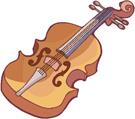 At last week’s meeting of the Colorado Genealogical Society, members showcased family heirlooms. My husband/tech advisor participated by displaying and discussing our family violin.
At last week’s meeting of the Colorado Genealogical Society, members showcased family heirlooms. My husband/tech advisor participated by displaying and discussing our family violin.
This instrument is quite old, and we have a record of its history. In 1977, his father wrote it down as he remembered it.
According to him, the instrument traveled from Norway to North Dakota in the 1850’s in the possession of the Wild family. Eventually Bill Wild sold it to an August Johnson. Mr. Johnson spent many winters on the farm of Anton Hjelmstad, my husband’s grandfather. Anton purchased the violin from August Johnson in 1931.
Anton played the violin for many years, until his death in 1957. He maintained it as best he could, occasionally restringing the bow with hairs from the tail of the horse in his barn.
My husband remembers times spent as a small child listening to his grandfather play. When he began his own violin lessons, he received the violin. He played it through high school, until he needed a better one.
The old violin saw some rough times through its history. Anton Hjelmstad had played it at barn dances, and it was damaged in a brawl at one of those. He repaired it, but eventually the front began to collapse. The violin became unplayable.
Now it sits in a shadow box along with some remembrances of its Norwegian heritage–a piece of Norwegian hardanger embroidery and a stalk of wheat like that grown by Anton Hjelmstad. It serves our family as a wonderful reminder of our roots.
Join Your Bygdelag
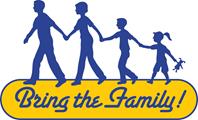 Anyone who has some Norwegian heritage and an interest in learning about Norwegian ancestry or native culture does not have to look far. Norwegians in America have long banded together to share their Norwegian ways.
Anyone who has some Norwegian heritage and an interest in learning about Norwegian ancestry or native culture does not have to look far. Norwegians in America have long banded together to share their Norwegian ways.
Most descendants probably know of the fraternal organization, the Sons of Norway (www.sonsofnorway.com). Women, too, can join this club and enjoy getting together for Norwegian food and activities.
Maybe fewer know about the numerous Bygdelagenes groups that focus on areas of origin in Norway. My family certainly never mentioned these organizations, so I do not think any of my Norwegian-American ancestors belonged to one. Most of the Bygdelagenes seem centered in Minnesota and Wisconsin whereas my family settled in faraway Montana.
I never knew the term Bygdelag until last weekend when I attended a Norwegian genealogy meeting. There I learned that over 30 of these groups exist, and each focuses on heritage from a particular county, or fylke, in Norway. Since my family emigrated from Nordland, I could join the Nordlandslag (http://www.nordlandslaget.com). Descendants of those from the far north in Norway, (the counties of Nordland, Troms, and Finnmark) belong to this group.
Maybe I will look into joining. Other members of my Norwegian genealogy group have found Bygdelag memberships fun and helpful. For just $15 a year I would receive a newsletter and the opportunity to attend an annual get-together called a stevne.
I cannot make this year’s June stevne in Minnesota, nor can we get to my husband/tech advisor’s Hedmarken Lag stevne in Wisconsin in August, but perhaps we could plan for one in the future. We do have relatives and ancestors in both states, and I am always looking for that next genealogy road trip.
Look for your Bygdelag and find some like-minded Norwegians today!